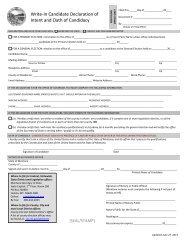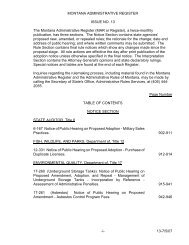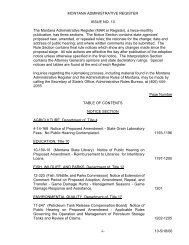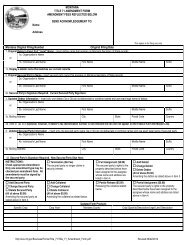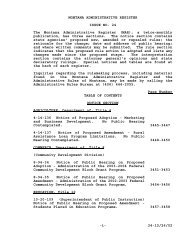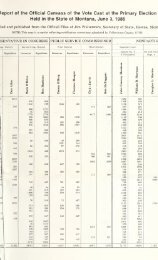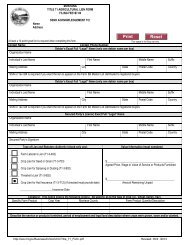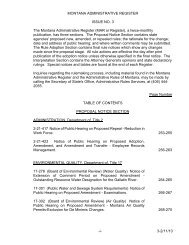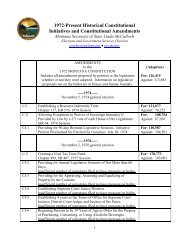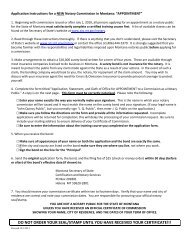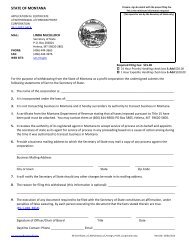Notary Handbook - the Montana Secretary of State Website
Notary Handbook - the Montana Secretary of State Website
Notary Handbook - the Montana Secretary of State Website
Create successful ePaper yourself
Turn your PDF publications into a flip-book with our unique Google optimized e-Paper software.
TYPES OF NOTARIAL ACTS<br />
There are seven legally authorized notarial acts in <strong>Montana</strong> law:<br />
Taking acknowledgements.<br />
Witnessing signatures.<br />
Verification upon oath or affirmation.<br />
Administering oaths.<br />
Certifying copies.<br />
Taking (transcribing) depositions.<br />
Making protests <strong>of</strong> instruments.<br />
When we talk about “notarizing a document” most <strong>of</strong> <strong>the</strong> time we really mean notarizing a signature in some way –<br />
<strong>the</strong> three most common notarial acts. Notarizing a signature might loosely be defined as au<strong>the</strong>nticating that<br />
signature. In <strong>Montana</strong> law <strong>the</strong>re are three levels <strong>of</strong> au<strong>the</strong>nticating a signature. These standard actions are<br />
described in <strong>the</strong> first three subparagraphs <strong>of</strong> 1-5-603, MCA:<br />
1-5-603. Notarial acts.<br />
(1) In taking an acknowledgment, <strong>the</strong> notarial <strong>of</strong>ficer shall determine, ei<strong>the</strong>r from personal knowledge or from satisfactory<br />
evidence, that <strong>the</strong> person appearing before <strong>the</strong> <strong>of</strong>ficer and making <strong>the</strong> acknowledgment is <strong>the</strong> person whose true signature is<br />
on <strong>the</strong> instrument. (2) In taking a verification upon oath or affirmation, <strong>the</strong> notarial <strong>of</strong>ficer shall determine, ei<strong>the</strong>r from<br />
personal knowledge or from satisfactory evidence, that <strong>the</strong> person appearing before <strong>the</strong> <strong>of</strong>ficer and making <strong>the</strong> verification is<br />
<strong>the</strong> person whose true signature is on <strong>the</strong> statement verified. (3) In witnessing or attesting a signature, <strong>the</strong> notarial <strong>of</strong>ficer<br />
shall determine, ei<strong>the</strong>r from personal knowledge or from satisfactory evidence, that <strong>the</strong> signature is that <strong>of</strong> <strong>the</strong> person<br />
appearing before <strong>the</strong> <strong>of</strong>ficer and named in <strong>the</strong> instrument.<br />
Acknowledgment - The least exacting process is <strong>the</strong> taking <strong>of</strong> an acknowledgment. Although this process requires<br />
<strong>the</strong> signer to appear before <strong>the</strong> notary, it does not require <strong>the</strong> notary to witness <strong>the</strong> act <strong>of</strong> signing. Often <strong>the</strong> party<br />
has mistakenly signed before realizing it should be done before a notary. In most cases, <strong>the</strong> requirement will be<br />
met if <strong>the</strong> signer acknowledges before <strong>the</strong> notary that he/she signed <strong>the</strong> document, and <strong>the</strong> notary <strong>the</strong>n merely<br />
attests to <strong>the</strong> fact that <strong>the</strong> signer personally acknowledged <strong>the</strong> signature in <strong>the</strong> presence <strong>of</strong> <strong>the</strong> notary and that <strong>the</strong><br />
notary has determined <strong>the</strong> identity <strong>of</strong> <strong>the</strong> signer as o<strong>the</strong>rwise required, and has verified <strong>the</strong> signature to be that <strong>of</strong><br />
<strong>the</strong> signer (usually by comparing <strong>the</strong> signature on <strong>the</strong> document to <strong>the</strong> signature on <strong>the</strong> ID and <strong>the</strong> one made by <strong>the</strong><br />
signer in <strong>the</strong> notary’s journal.) See pages 34 - 35 for examples <strong>of</strong> proper acknowledgements by individuals.<br />
An acknowledgement can also be made by an individual acting (signing) on behalf <strong>of</strong> ano<strong>the</strong>r person or entity. This<br />
is called an acknowledgement in a representative capacity and <strong>the</strong> person who is appearing before <strong>the</strong> notary will<br />
be signing on behalf <strong>of</strong> a business or corporation, a trust, a Power <strong>of</strong> Attorney or with some o<strong>the</strong>r authorization<br />
that allows <strong>the</strong>m to sign for ano<strong>the</strong>r person or legal entity. When notarizing a document that is being signed by<br />
someone o<strong>the</strong>r than <strong>the</strong> person or entity designated as <strong>the</strong> signer, <strong>the</strong> notary should determine (1) <strong>the</strong> identity <strong>of</strong><br />
<strong>the</strong> person who is actually signing <strong>the</strong> document, (2) <strong>the</strong> capacity <strong>of</strong> <strong>the</strong> person to sign on behalf <strong>of</strong> <strong>the</strong> person or<br />
entity, and (3) <strong>the</strong> authority to sign for that person or entity in this particular transaction. See page 40 for more<br />
information and examples <strong>of</strong> proper acknowledgements by persons signing in a representative capacity.<br />
Verification upon oath or affirmation – JURAT - The most demanding process is taking a verification upon oath or<br />
affirmation. The notary not only witnesses <strong>the</strong> signature which must be made in his/her presence and must<br />
au<strong>the</strong>nticate <strong>the</strong> identity <strong>of</strong> <strong>the</strong> signer, but he/she must also administer an oath and affix a jurat to reflect that <strong>the</strong><br />
signer swore or affirmed <strong>the</strong> truth <strong>of</strong> <strong>the</strong> document signed. A jurat includes an oath by <strong>the</strong> signer that <strong>the</strong><br />
statements made in <strong>the</strong> document are true. For some legal uses, <strong>the</strong> document would be inadmissible or useless if<br />
<strong>the</strong> jurat is not properly prepared. <strong>Montana</strong> motor vehicle titles and contractor license applications are two <strong>of</strong> <strong>the</strong><br />
most commonly seen documents requiring jurat notarizations. See pages 38 - 39 for examples <strong>of</strong> correct formats<br />
for this type <strong>of</strong> notarial block.<br />
13



